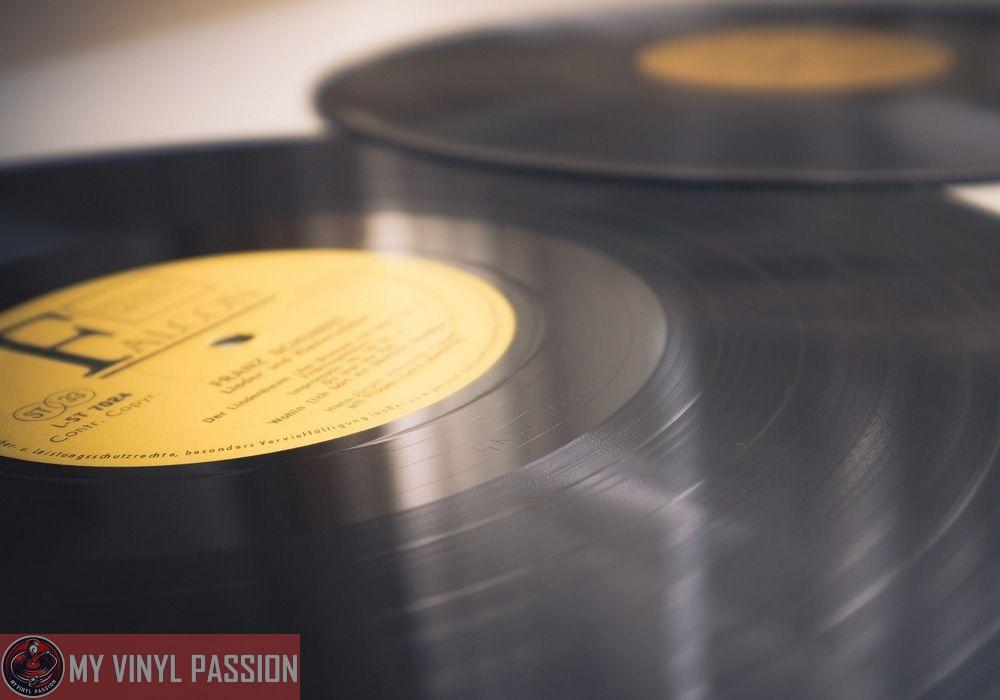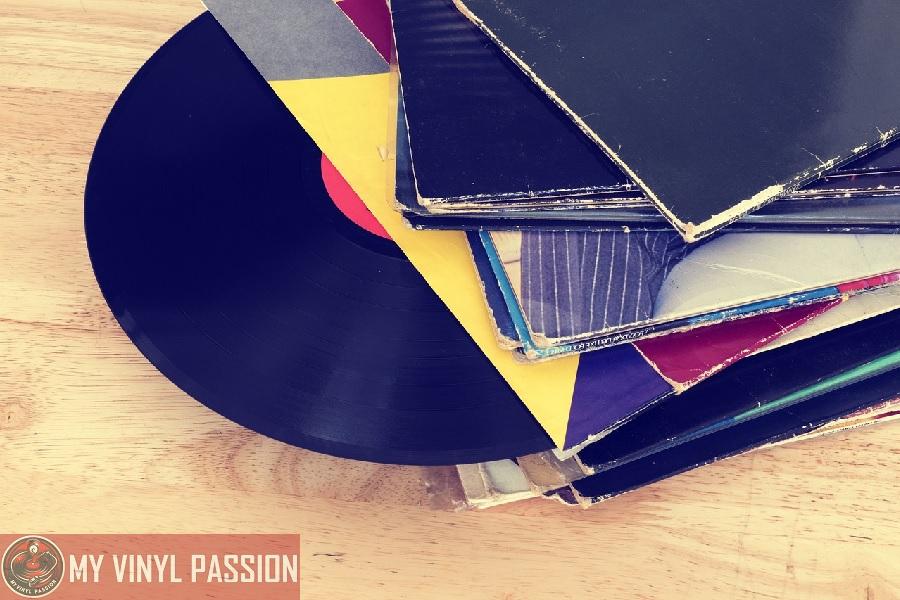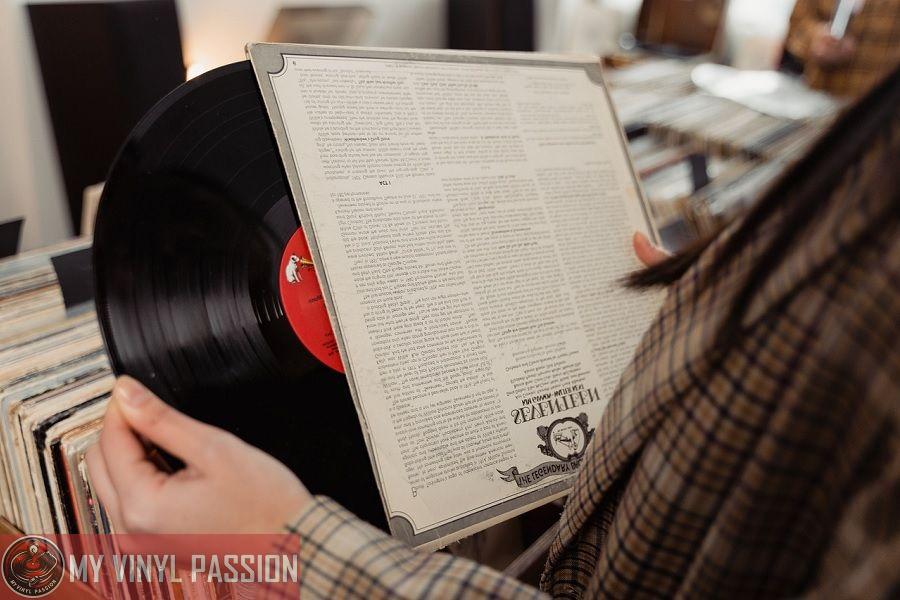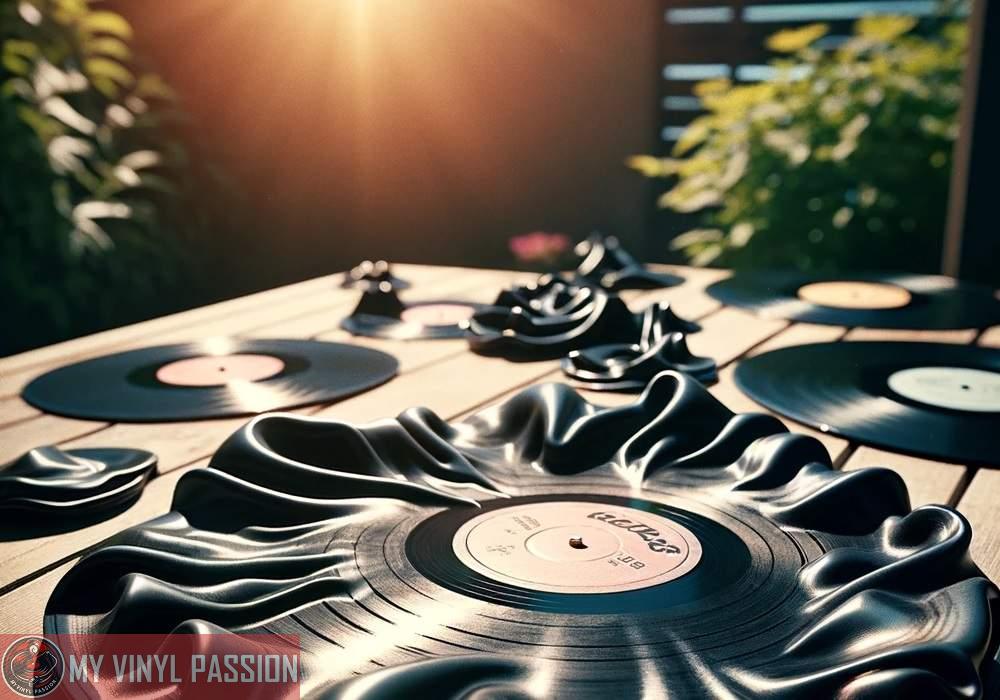A vinyl record, commonly known as an LP (long play) or simply a record, is an analog sound storage medium first introduced in the early 20th century.
Composed of polyvinyl chloride (PVC), it provides a unique listening experience by capturing sound in the form of microscopic grooves on its surface. When you play a vinyl record on a turntable, a needle, or stylus, tracks these grooves, vibrating to reproduce the recorded sound waves.
In Summary
A vinyl record is a disc made of polyvinyl chloride (PVC) used for analog sound storage, with audio information encoded in the form of a modulated spiral groove.
The sound on a vinyl record is reproduced by a turntable’s needle (stylus) running along the grooves, converting the physical movements into audio signals.
Vinyl records come in different sizes and speeds, with the most common being the 12-inch LP (Long Play) at 33 1/3 RPM and the 7-inch single at 45 RPM.
Vinyl records are renowned for their warm, rich sound quality and are often preferred by audiophiles and music enthusiasts for their analog audio characteristics.
The resurgence of vinyl records in recent years has reintroduced you to their distinct auditory qualities and tangible value.
Unlike the ephemeral nature of digital music, a vinyl record offers you a tactile connection to music, from the large album artwork to the ritualistic process of playing a record. This physical interaction with music can offer a sense of ownership and nostalgia that digital formats often lack.
Understanding vinyl goes beyond mere format; it involves recognizing the cultural and historic significance that vinyl has carried through decades.
As a connoisseur of music, engaging with vinyl allows you to feel connected to a richer history of audio recording and music distribution. This feeling is part of the reason vinyl records have seen a sustained revival in a world dominated by digital convenience.
History and Evolution
Vinyl records have a storied past that charts the course from innovative scientific discovery to cultural icon.
Their evolution is intrinsically linked to the development of the music industry and audio technology, with a recent resurgence underscoring their enduring appeal.
From Phonographs to Modern Turntables
Thomas Edison’s invention of the phonograph in 1877 marked the dawn of sound recording—a cylinder wrapped in tin foil was his rudimentary yet revolutionary starting point.
Not long after, Emile Berliner introduced the gramophone in the 1890s, which made use of flat discs, an approach that laid the groundwork for the modern vinyl format.
- Phonograph: Invented in 1877, used cylinders.
- Gramophone: Came next, introduced flat discs.
- Records: Transitioned from shellac to vinyl material.
The record player evolved into turntables that we know today, allowing your vinyl collection to thrive.
Revival of Vinyl Records
You may have heard of vinyl’s comeback, an evident trend since the early 2000s. Records offer a tangible connection to music in an increasingly digital age, prized for their analog warmth and rich cover art.
The vinyl record industry has seen substantial growth, triggering a renewed production of records and turntables.
- Revival drivers: Nostalgia, analog audio’s distinct quality, collector’s market.
- Vinyl format: Appreciated for its full, uncompressed sound.
Your understanding of this history of vinyl should not only guide your appreciation for its past but also enable you to be a part of its living legacy.
Manufacturing Process
The manufacturing of vinyl records is a meticulous blend of science and artistry, starting with the creation of a master disc and ending with the pressing of the final product.
You’ll be taken through the critical stages where engineers and materials come together to craft the unique sound of vinyl.
Creating Master Discs
To begin your vinyl record, the mastering engineer plays a pivotal role, ensuring the audio is perfectly tuned for the medium. Your master disc is created using a lathe, a precision device that etches the audio grooves onto a lacquer-coated aluminum disc.
This lacquer disc serves as the original from which all copies will be cast. The skill of the cutting engineer is in balancing depth and spacing of grooves, as these physical dimensions translate to the nuances of audio playback.
Pressing and Materials
After the master disc is cut, electroplating is employed, a process that converts the master disc into a “stamper” capable of handling mass production. Once stampers are made, they are placed into a record press.
This press uses polyvinyl chloride (PVC), a durable plastic, to create the final record. Heat and pressure are applied to PVC pellets or “biscuits” between the stampers to form the recognizable disc.
Vinyl, as opposed to its historical predecessor shellac, provides a flexible yet sturdy base for the intricate grooves that bear the sound.
Technical Specifications
Understanding the technical specifications of vinyl records is key to appreciating their unique sound quality and physical characteristics. Here, you’ll gain insights into their rotational speeds, sizes, and the intricacies of how grooves capture audio.
Understanding RPM and Sizes
Vinyl records are categorized by their rotational speed, measured in revolutions per minute (RPM), and their diameter, typically in inches. The common formats you’ll encounter are:
- 12-inch records that usually play at 33 ⅓ RPM, holding about 22 minutes of music per side.
- 7-inch records spinning at 45 RPM, which are often singles and can contain up to 5 minutes of music per side.
- 10-inch records, which can be found at both 33 ⅓ and 78 RPM; the latter was standard before the 1950s.
These specific sizes and speeds affect not only how much music can be stored but also the fidelity and nuances of audio reproduction that audiophiles might seek in a vinyl record.
Grooves and Sound Reproduction
The audio on a vinyl record is stored in the modulated spiral groove that starts near the outer edge and ends towards the center. A single groove is microscopic and exact, able to capture a wide range of sounds.
The quality of sound reproduction relies heavily on the:
- Grooves per inch: A higher number can result in better sound quality.
- Depth and width of grooves: These impact the volume and quality of audio recording.
Records are manufactured with a certain amount of grooves designed to accommodate the frequencies of the audio they contain. The analog nature of the sound carved into these grooves is often preferred by audiophiles for its warmth and fullness compared to digital formats.
Equipment and Accessories
To fully appreciate the vinyl experience, your setup requires specific equipment and accessories, each contributing to the overall sound quality. From the translation of grooves into audio signals to the amplification that fills the room, understanding these components is essential.
Turntables and Styluses
Your turntable acts as the foundation of vinyl playback. It must rotate records at a constant speed—33 1/3 or 45 revolutions per minute (RPM)—to ensure accurate sound reproduction.
Modern turntables come with various features like adjustable counterweights and anti-skating controls for optimal stylus performance. The stylus or needle, typically made from diamond or another hard material, traces the record’s grooves and vibrates accordingly.
Its precision affects the fidelity of sound, making it imperative for audiophiles to invest in a high-quality stylus.
- Key Components of a Turntable:
- Platter: The rotating surface that holds and spins the vinyl.
- Tonearm: Holds the stylus and cartridge, must be properly balanced.
- Cartridge: Transduces mechanical vibrations into electrical signals.
Amplifiers and Speakers
To hear the sound from your vinyl, the electrical signals sent by the turntable’s cartridge must be amplified.
An amplifier does this job, increasing the signal strength before sending it to your speakers. There are integrated amplifiers that combine pre-amplifiers and power amplifiers, useful for saving space.
The speakers convert the amplified signals into sound waves, with options ranging from compact bookshelf models to larger floor-standing units designed for more powerful audio output.
For a truly immersive experience, make sure your speakers have a wide frequency response and offer clear, distortion-free sound.
- Key Aspects of Amplifiers and Speakers:
- Amplifier Types: Integrated, pre-amplifier, power amplifier.
- Speaker Varieties: Bookshelf, floor-standing, in-wall, outdoor.
By integrating a high-quality turntable with a precision stylus, and pairing it with a robust amplifier and responsive speakers, you create an optimized audio system capable of delivering the rich and nuanced sounds that vinyl records have to offer.
The Culture of Vinyl
Vinyl records represent not just a medium for music playback but a cultural artifact that resonates with your sense of nostalgia and authenticity. They offer a tangible connection to music that many find deeply satisfying.
Collectors and Limited Editions
You, as a collector, understand the thrill of seeking out limited edition pressings.
They often come in unique colors or possess rare artwork, making them prized possessions within your vinyl collection. Limited editions often commemorate significant albums or events, like the release of a groundbreaking Beatles album.
Collectors scour the market for these rarities, driving the culture of exclusivity and passion within vinyl communities.
Examples of Limited Edition Collectibles
- Colored Records: Pressed in limited numbers, these records can be visually striking and a favorite among your collector’s items.
- Special Pressings: Albums with alternative covers, signed by artists, or including bonus tracks.
Vinyl in the Music Industry
Vinyl records have made a notable resurgence, even in the age of streaming services.
They offer you a unique listening experience that is valued by enthusiasts and DJs alike for its rich sound quality. Record labels have taken notice and often release vinyl versions of new albums, catering to the demand for physical media.
The tactile nature of handling a record and the interactive experience of playing it on a turntable can make you feel more connected to the music. Vinyl subscription services have emerged, allowing you to grow your collection with curated selections that mirror your musical taste.
Vinyl vs. Digital
- Record Sales: Despite the convenience of digital, vinyl sales have seen a steady increase, indicating your strong desire for physical music formats.
- Music Industry Trends: Artists often release on vinyl to satisfy your demand, and it is not uncommon for a vinyl release to chart alongside digital releases.
In the world of hip-hop, vinyl holds a special place, with DJs using records for scratching and mixing, showcasing the enduring appeal of vinyl in contemporary music settings.
FAQs
What material are vinyl records made of?
Vinyl records are made from polyvinyl chloride (PVC), a type of plastic that allows for the recording and playback of sound through a modulated spiral groove.
How is sound played back from a vinyl record?
Sound is played back from a vinyl record by a turntable’s needle (stylus) tracing the grooves on the record’s surface, converting the groove vibrations into electrical signals that are amplified into sound.
What are the common sizes and speeds of vinyl records?
The most common sizes are the 12-inch LP (Long Play) played at 33 1/3 RPM and the 7-inch single played at 45 RPM. There are also 10-inch records and older formats that play at 78 RPM.
Why do some music enthusiasts prefer vinyl records?
Many music enthusiasts prefer vinyl records for their warm, rich sound quality, the tactile experience of handling records, and the artistic value of album covers and vinyl aesthetics.
Can vinyl records be damaged easily, and how should they be cared for?
Vinyl records can be susceptible to scratches, warping, and dust accumulation. They should be stored vertically in a cool, dry place, handled by their edges, and cleaned regularly with a soft brush or appropriate cleaning solution.





